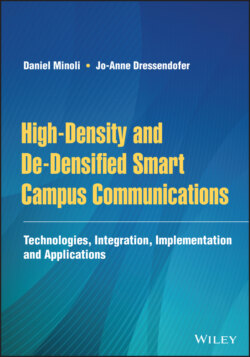Читать книгу High-Density and De-Densified Smart Campus Communications - Daniel Minoli - Страница 15
1.2 REQUIREMENTS FOR HIGH‐DENSITY COMMUNICATIONS
ОглавлениеHDC can be characterized by several (requirement) metrics. Basic metrics include, but are not limited to, user connection density, traffic volume density, experienced data rate, and peak data rate. Many venues require ultra‐high connection density and ultra‐high traffic volume density; applications that entail M2M and may typically (but not always) require very low end‐to‐end latency. For example, 5G systems aim at the following key performance indicators: (i) connection density: one million connections per square kilometer; (ii) traffic volume density: tens of Gbps per square kilometer; (iii) user experienced data rate: 0.1–1 Gbps; (iv) peak data rate: tens of Gbps, and; (iv) end‐to‐end latency: 1–10 ms. See Figure 1.1. In addition, there is a need for scalability: it is one thing to have high density in a small area (say, a classroom), and it is another matter to be able to sustain that over a large venue (for example, a stadium or airport). For this discussion, it is assumed that the mobility speed is not a factor: pedestrian rates (≤10 km/h) are assumed.
One million connections per square kilometer (also definable as 1 connection per m2) equates to one connection every 10 ft2 (1 km2 = 10 763 910 ft2); this is considerably higher than the connectivity goals in an office environment, where typically one has an allocated space of 130–150 ft2 per worker, with one or two connections per worker; this is also higher than the connectivity in a classroom (say a 40 × 40 ft locale and 32 students, or one connection every 50 ft2). Another example could be train cars with 200 users (perhaps not all simultaneously active) in 1000 ft2, or one connection every 10 ft2 if only 50% of the passengers are active at any one point in time.
FIGURE 1.1 Requirements bouquet.
TABLE 1.1 Key Performance Indicators HDC Key Performance Indicators (KPIs)
| Key Performance Indicators | Description |
|---|---|
| Connection density | Total number of connected devices per unit area (n/km2) |
| User experienced data rate | Minimum data rate for a user in the actual network environment (bps) |
| Peak data rate | Maximum achievable data rate per user (bps) |
| Traffic volume density | Total data rate of all users per unit area (bps/km2) |
| End‐to‐end latency | Time lag between the transmission of a data packet from the source and the successful reception at the destination (ms) |
| Scalability | The ability to retain the above‐defined KPIs over large venues and/or geographic areas |
In addition to traditional communications, evolving requirements for high‐density environments include wearables (for example, in augmented reality applications), M2M, and vehicular traffic in Intelligent Transportation Systems (ITSs) environments. For example, densities of 1 node per m2 have been identified for augmented reality applications, as with Personal Area Network (PAN) mechanisms [10]. For ITSs, vehicle density has been one of the main metrics used for assessing road traffic conditions: a high vehicle density usually indicates that the road or street is congested [11]; the communication traffic is comprised of beacon signals and user‐generated signals. A congested road with stopped vehicular traffic might have, say, 12 cars in an area of 2500 ft2, or a density of 1 car in about 200 ft2 – each car could have multiple user sessions. Beyond user counts, the requirements span data rates, as highlighted in Table 1.1; some M2M and process control applications have stringent reliability and latency requirements. Applications such as Ultra HD video Streaming Over The Top (OTT), augmented reality, and online gaming impose challenging requirements on bandwidth and latency; however, these applications are not expected, in the short term at least, to have major deployment in mobile environments, but more so in stationary domiciled environments.
Additional key factors to take into consideration when deploying a state‐of‐the‐art HDC system include spectrum utilization, energy consumption, and infrastructure and endpoint system cost [2]. Spectrum efficiency is measured as the data throughput per unit of spectrum resource per cell or per unit area (bps/Hz/cell or bps/Hz/km2); energy efficiency is quantified in terms of the number of bits that can be transmitted per unit of energy (bits/J); infrastructure cost efficiency can be defined by the number of bits that can be transmitted per unit cost as computed from network infrastructure amortization/allocation (bits/$); endpoint system costs are clearly the endsystem costs, especially for the air interface and the protocol stack resources, to support a given maximum throughput; applicable to human devices (e.g. smartphones) and M2M systems. Improvements in these metrics of one‐to‐two orders of magnitude are being sought compared with legacy environments.
A number of use cases follow.
